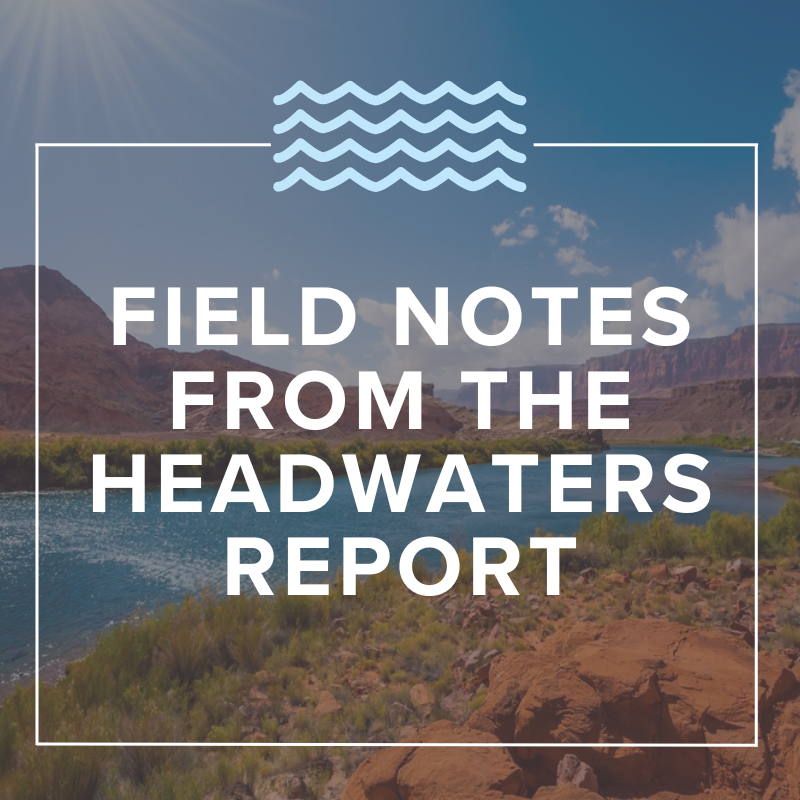By: Daniel Cordalis
May 21, 2025
Published as part of The Headwaters Report

The first 100 days of the second Trump administration have been very busy. The president has signed more than 140 executive orders, many testing the limits of executive authority, and signed dozens of proclamations and memorandums setting out new policy directives. These directives are reshaping how the federal government operates and what issues it prioritizes. The new administration is engaging in widespread agency staffing reduction initiatives, major regulatory changes designed to reduce perceived regulatory burdens, federal funding cuts and freezes, and removal of equity- and climate-based initiatives. Through executive policy making, the White House is altering international trade practices and reshaping domestic policy to increase energy production from federal public lands. Understandably, there is a lot of social unease, and the economy is reacting negatively to the rapid changes and uncertainty. These changes are not insubstantial. To be clear: these are significant departures from established federal policies and practices that constitute a drastic reformation of government operations.
So far, tens of thousands of federal employees across the federal government have either resigned or been fired, and there are numerous agency reorganization initiatives and reductions in force (known as “RIF”) taking place that will likely not be completed for months. These staffing reductions and agency changes will likely negatively impact Tribal Nations and the public’s ability to interact with the federal government both to implement and enforce federal policy and the law. NARF is tracking closely how these new efforts are affecting Indian Country and we will take action when needed to protect the rights of Tribal Nations, such as our lawsuit challenging funding and staff reductions at Bureau of Indian Education schools.
On the environmental front, the White House has issued overarching climate-related directives, including executive orders to withdraw from the Paris climate agreement, to increase domestic energy production on public and private lands, and to bypass environmental justice, as well as state laws and policies aimed at combatting climate change. On the ground, the administration is working to scale back environmental protections and programs, particularly at the Environmental Protection Agency (EPA) under Administrator Lee Zeldin. For example, EPA is revisiting its 2009 conclusion that carbon dioxide endangers human health and welfare (the endangerment finding), a conclusion that allowed EPA to regulate carbon dioxide as a greenhouse gas under the Clean Air Act. EPA is also accepting input into how it defines “waters of the United States” for Clean Water Act jurisdictional purposes.
Other agencies are also working to undo current regulatory requirements that may impede energy and other economic development. In late April, the U.S. Fish and Wildlife Service and the National Oceanic and Atmospheric Administration proposed to modify what it means to “harm” wildlife so Endangered Species Act protections would not include modification of wildlife habitat, making it easier to develop and use land where endangered species live.
While we have seen a lot of activity from cabinet-level political appointees working to enact the president’s agenda, the administration has been very slow (as it was in 2017) to fill in other political appointments, but that is picking up a bit now that we are into mid-May. This is causing some stagnation in issue areas that the administration does not have a particular focus on, including water issues (other than supporting irrigators in California and in the Upper Klamath River Basin). Of particular concern for water-related issues: we still do not have a Commissioner of the Bureau of Reclamation.
Interior Department
We do not have clarity on how the Interior Department will direct policy regarding Tribal water issues. Interior Secretary Doug Burgum made affirmative comments supporting the resolution of Tribal water issues through settlement in his confirmation hearing, but little has happened since. For now, Scott Cameron, a Senior Advisor to the Secretary and Interior Department appointee under the first Trump Administration, has been Interior’s lead on Colorado River management negotiations. Three other Interior Department nominees will be critical to support Tribal water: Billy Kirkland (Navajo/Diné), nominated for Assistant Secretary for Indian Affairs; Andrea Travnicek, nominated for Assistant Secretary for Water and Science, and; William Doffermyre, nominated to be Solicitor of the Department of the Interior. Travnicek and Doffermyre are in the Senate confirmation process, but Kirkland will not onboard until this summer. As such, we will have to wait to see how the department’s political appointee staffing shapes up and what direction leadership will take on Tribal water issues.
The Interior Department is the lead federal department handling Tribal water issues and a handful of Interior agencies and programs work on them, including the Bureau of Indian Affairs, the Secretary’s Indian Water Rights Office (SIWRO), the Bureau of Reclamation, the Solicitor’s Office, the Indian Trust Litigation Office, and often Secretary’s counselors and advisors.
Finally, one of Indian Country’s most dedicated federal employees, Pam Williams, SIWRO director, retired on April 18. Pam, with thirty-five years of federal service in the Interior Department working on Tribal water rights settlements, will be missed tremendously and we thank her for her service on incredibly difficult and important issues.
Congressional Activity
In Congress, Tribal Nations have been quick to reintroduce water-related legislation in both the Senate and House of Representatives. Because none of the twelve Tribal water rights settlements or settlement amendments bills passed at the end of 2024, the Tribes must restart the congressional approval process. The Senate Committee on Indian Affairs passed six water rights settlement bills on March 5, 2025, and the bills will next head to the Senate floor for consideration. The House of Representatives has not held any hearings on the bills in its chambers.
Immediately, Congress, and the House of Representatives specifically, is consumed with drafting and negotiating the budget reconciliation bill. The budget reconciliation bill is legislation addressed at budget-specific items like spending and revenues or changing the debt limit. General policy issues are not allowed in the reconciliation bill, although much of the bill includes items that reflect policy proposals. Reconciliation is a special process that allows the Senate to pass legislation with only a simple majority, 51 votes, rather than the 60 votes typically needed.
Each House committee drafts its piece of the bill. The House Natural Resources Committee’s portion seeks to increase fossil fuel production and mining on public lands, while cutting environmental reviews. Included in the bill are:
- Reinstatement of two mining projects blocked by Biden Administration, Ambler Road through the Gates of the Arctic National Park and Preserve, Alaska, and Twin Metals in Minnesota’s Boundary Waters Canoe Area Wilderness.
- Requirements that the Interior Department offer up 30 chances for companies to bid on opportunities to drill in the Gulf of Mexico over the next 15 years.
- Requirements that six similar auctions to be held for drilling inside Alaska’s Cook Inlet.
- A late amendment to sell certain public lands in Nevada and Utah.
- The reinstatement of leases to drill in the Arctic National Wildlife Refuge and four new drilling auctions there.
- Additional Arctic drilling opportunities in the National Petroleum Reserve-Alaska.
- $2.5 billion for California water storage and conveyance improvements funding, aimed at raising Shasta Dam and increasing water storage in Shasta Reservoir.
- Pay-for expedited environmental reviews (NEPA), reviews would then be exempted from court challenge.
- More opportunities to mine for coal on federal public lands.
House committees are working through their approval process, but it appears there will be a lot of negotiating to get the bill passed.
In all, there is a lot of activity to redefine the federal government’s role as public trustee and to create more energy development and fewer environmental restrictions. We are tracking all the policy developments and will continue to provide monthly updates on issues of importance to Indian Country.
Events We are Tracking
- University of Colorado School of Law, Getches-Wilkinson Center, 2025 Conference on the Colorado River
- National Congress of American Indians Mid-Year Conference


